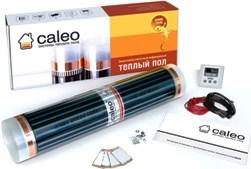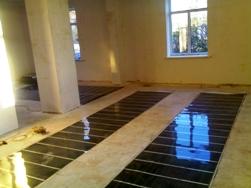Categories: Featured Articles » Interesting electrical news
Number of views: 23950
Comments on the article: 3
Infrared film underfloor heating
 Appearance infrared film underfloor heating in the market of services - a clear example of how innovative technologies are boldly entering our lives, helping to create coziness and comfort in the house easily and quickly.
Appearance infrared film underfloor heating in the market of services - a clear example of how innovative technologies are boldly entering our lives, helping to create coziness and comfort in the house easily and quickly.
The fundamental difference and the main advantage of the infrared floor from other floors is the use of infrared radiation. This long-wave radiation does not heat the air, but directly the objects in the room.
An ordinary warm floor, heating the air, creates convection currents in it, which rise up. As a result, you spend energy on creating a warm layer of air under the ceiling, and not in the part of the room where you are.
The infrared floor warms the entire room evenly. Moreover, infrared rays they do not dry air, do not create dust circulation in a confined space (which is especially important for allergies and respiratory diseases) and emit a large number of negative ions. All this greatly improves the indoor microclimate.
 What is an infrared film warm floor? This is an ultra-thin (only 0.4 mm), flexible material consisting of two layers of a polymer film, between which heating elements are hermetically sealed - parallel graphite strips with special additives, connected to silver-plated copper tires.
What is an infrared film warm floor? This is an ultra-thin (only 0.4 mm), flexible material consisting of two layers of a polymer film, between which heating elements are hermetically sealed - parallel graphite strips with special additives, connected to silver-plated copper tires.
Film underfloor heating can be installed not only under light flooring, such as linoleum, carpet and laminate, but also under such materials as ceramic tiles or porcelain tiles.
Installation of a film floor does not require such a time-consuming and dirty process as a screed. It is easy to carry out the installation of the infrared film floor on your own, and in a short time. You do not need special tools and skills, just read the instructions carefully.
The only thing you should remember is that according to current regulations, only a qualified electrician can connect a warm floor. Connection is made to a simple power supply network with a voltage of 220 V. You can correct the heating temperature with the help of a temperature regulator.
Where and for what is infrared film underfloor heating used?
Thermal film - environmentally friendly material that does not emit toxic fumes, is absolutely safe to use.
 Film floor does not create electromagnetic radiation, slightly ionizes and refreshes the air. All this allows the use of such floors for premises of any purpose: houses, apartments, cottages, kindergartens, medical institutions. Due to its flexibility, small thickness and ease of installation, thermal film can be used for heating vertical and horizontal surfaces - walls, ceilings.
Film floor does not create electromagnetic radiation, slightly ionizes and refreshes the air. All this allows the use of such floors for premises of any purpose: houses, apartments, cottages, kindergartens, medical institutions. Due to its flexibility, small thickness and ease of installation, thermal film can be used for heating vertical and horizontal surfaces - walls, ceilings.
Infrared underfloor heating can serve not only for additional heating, but also completely replace traditional heating sources. In this case, the area of the infrared film should be at least 70% of the floor area of the heated room.
Since the film floor consists of a large number of parallel electrically conductive elements, it cannot burn out all at once. If one of the plates fails, its functions will be evenly distributed to the others and the heating temperature will not change.
The infrared floor can not be mounted under furniture on low legs - sofas, cabinets, chests of drawers. In this case, local overheating will occur, and individual elements may fail.
Although infrared-heated film floors are a fairly young category of underfloor heating, they have already won the undisputed leadership due to their high energy efficiency and great economy.
See also at bgv.electricianexp.com
:
